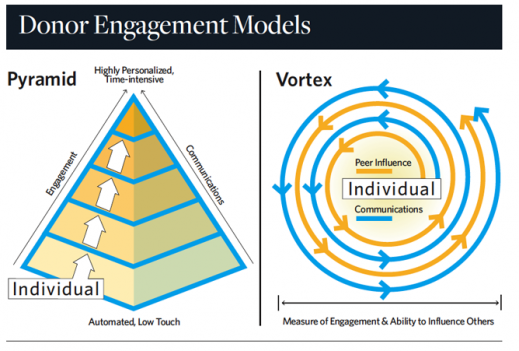How many of you had to teach your moms how to use Facebook? I sure did. In fact, I’m still uploading photos for her every time I visit.
The truth is, the advent of social media has radically changed the way we do everyday life, and even business. Its ramifications are rippling outward, and nonprofits are catching on.
The Stanford Review gives an in-depth study on how social media has impacted the way people engage with causes, but I’m here to give you the skinny.
Essentially, there are two models: the old and the new – the pyramid and the vortex.

The Pyramid
In the old theory of engagement, people start at the bottom level of the pyramid and slowly move upwards. It is a nice, orderly, linear progression. With increased communication, some people would move up and make larger donations. Easy-peasy.
Direct marketing and mailing is the primary way to communicate with people at the lowest level, and in-person outreach is reserved for the select few with deep pockets. There are specialized communication methods for each level.
In this model, everyone starts at the bottom. There’s no way to understand someone who exists at multiple levels or moves between them.
This is also very one-sided. The nonprofit reaches out to the donor, and that’s about it.
The Vortex
Contrary to what some have proposed, social media does not sub in for the lowest level of the pyramid – it’s a new model entirely.
Here, the individual is at the center of a vortex. As their level of engagement and influence increases, so do the layers swirling around them.
In the vortex, there are multiple gateways to engagement, and movement between levels is fluid. There is a nonlinear progression, and people are often engaged at various levels at the same time.
People often connect with an organization offline first, whether by donating, volunteering, talking with friends and family, or reading articles. They can then take steps of interacting on different platforms online – whether through blogging, or Facebook and Twitter.
Communication is multifaceted, and no longer one-sided. Supporters will voice their thoughts back to you on a public platform, and they will also interact with and influence each other online.
Peer influence, in fact, is a critical new element that shouldn’t be underestimated. In the pyramid, a person’s value was determined by how much they donate – in the vortex, someone might make a small contribution, but influence 25 others to do the same.
How to Adapt
In order to keep up, you’ve got to change your communication strategies. There are three core principles to adapting to a social-media-driven world:
1. Redefine contribution
A monetary donation is not the only valuable outcome or engagement you can get from your supporters. Influence is also highly desirable and is often linked to engagement with social media. Start thinking of the various layers of the vortex as all positive results and interactions.
2. Diversify calls to action
In short, you get what you ask for. If you’re only asking for a donation, people are going to think that that is the only meaningful way to be a supporter. This might turn some people off. Include appeals for Tweets, shares, and email forwards in your call to action, and people will respond.
3. Sustain continuous communication
This might seem like the most challenging, but is now a demand for communications strategy. Think of everyone in your organization as a communicator, and train them with the skills to do so. You can also think of your supporters as ambassadors, who will get the word out and do a lot of your communicating for you. One of the best ways to do this is to allow donors to start their own fundraising campaigns. And remember, the best communications strategy integrates both online and offline channels.
And there you have it! What does your social media strategy look like at your nonprofit? Are you still on the pyramid model? Have you embraced the vortex? Or are you somewhere in-between? Share in the comments!




